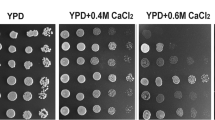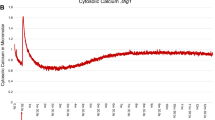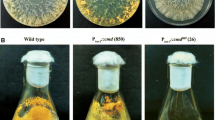Summary
A cal1-1 mutant of the yeast Saccharomyces cerevisiae showing Ca2+-dependent growth was isolated. Its growth continued exponentially in Ca2+-rich medium, but stopped in Ca2+-poor medium at 37°C. Mg2+ ions could not replace Ca2+ ions. In Ca2+-poor medium, the mutant cells stopped growing homogeneously at the stage of cell division cycle with a tiny bud. The nucleus in these arrested cells was in the G2 stage, judging from observation after nuclear staining and determination of the DNA content. Trifluoperazine-dependent pseudorevertants, which could grow in the presence of 20 μM to 80 μM trifluoperazine in Ca2+-poor medium at 37°C, were obtained from this cal1-1 mutant. The suppressor mutation, tfrl, itself conferred trifluoperazine resistance. Other calmodulin inhibitors structurally unrelated to trifluoperazine had similar effects to trifluoperazine on these pseudorevertants. These results suggest that Ca2+ ions and a calmodulin play important roles in the yeast cell division cycle at the stage of bud growth and nuclear division.
Similar content being viewed by others
Abbreviations
- Tfp:
-
trifluoperazine
- DAP1:
-
4′6-diamidino-2-phenylindole
- EMS:
-
ethyl methanesulfonate
- PD:
-
parental ditype
- NPD:
-
nonparental ditype
- T:
-
tetratype
References
Cheung WY (1980) Calmodulin plays a pivotal role in cellular regulation. Science 207:19–27
Duffus JH, Patterson LJ (1974) Control of cell division in yeast using the ionophore. A23187 with calcium and magnesium. Nature (London) 251:626–627
Fernandez MP, Correau JU, Cabib E (1982) Activation of chitin synthetase in permeabilized cells of a Saccharomyces cerevisiae mutant lacking proteinase B. J Bacteriol 152:1255–1264
Greer C, Schekman R (1982) Calcium control of Saccharomyces cerevisiae actin assembly. Mol Cell Biol 2:1279–1286
Halbreich A (1979) Differential effect of Ca2+ on the translation of yeast mitochondrial and some viral RNA's in an E. coli cell-free system. Biochem Biophys Res Commun 86:78–87
Hartwell LH (1976) Sequential function of gene products relative to DNA synthesis in the yeast cell cycle. J Mol Biol 104:803–817
Hartwell LH, Mortimer RK, Culotti J, Culotti M (1973) Genetic control of the cell division cycle in yeast: V. Genetic analysis of cdc mutants. Genetics 74:267–286
Hubbard M, Bradley M, Sullivan P, Shepherd M, Forrester I (1982) Evidence for the occurrence of calmodulin in the yeasts Candida albicans and Saccharomyces cerevisiae. FEBS Lett 137:85–88
Kakinuma Y, Ohsumi Y, Anraku Y (1981) Properties of H+-translocating adenosine triphosphatase in vacuolar membranes of Saccharomyces cerevisiae. J Biol Chem 256:10859–10863
Kakiuchi S (1981) Calmodulin and cytoskeletal system. Seikagaku (Tokyo) 53:1267–1289
Klee CB, Crouch TH, Richman PG (1980) Calmodulin. Annu Rev Biochem 49:489–515
Lindegren G, Hwang YL, Oshima Y, Lindegren CC (1965) Genetical motants induced by ethyl methanesulfonate in Saccharomyces. Can J Genet Cytol 7:491–499
Means AR, Dedman JR (1980) Calmodulin — an intracellular calcium receptor. Nature (London) 285:73–77
Moir D, Stewart SE, Osmond BC, Botstein D (1982) Cold-sensitive cell-division-cycle mutants of yeast: Isolation, properties, and pseudoreversion studies. Genetics 100:547–563
Ohsumi Y, Anraku Y (1983) Calcium transport driven by a proton motive force in vacuolar membrane vesicles of Saccharomyces cerevisiae. J Biol Chem 258:5614–5617
Penman CS, Duffus JH (1975) 2′-Deoxyadenosine and A23187 as agents for inducing synchrony in the budding yeast, Kluveromyces fragilis. J Gen Microbiol 90:76–80
Pringle JR, Hartwell LH (1981) The Saccharomyces cerevisiae cell cycle. In: Strathern JN, Jones EW, Broach JR (eds) The molecular biology of the yeast Saccharomyces. Cold Spring Harbor Laboratory, Cold Spring Harbor, NY, p 97–142
Sherman F, Fink GR, Hicks JB (1981) In Methods in yeast genetics. Cold Spring Harbor Laboratory, Cold Spring Harbor, NY, p 1–119
Simantov R, Nadler H, Levy R (1982) A genetic approach to reveal the action of the opiate receptor in selected neuroblastomaglioma cells. Eur J Biochem 128:461–466
Sora S, Bianchi M (1982) Propranolol, atenolol, and trifluoperazine reduce the spontaneous occurrence of meiotic diploid products in Saccharomyces cerevisiae. Mol Cell Biol 2:1299–1303
Speaker MG, Sturgill TW, Orlow SJ, Chia GH, Pifko-Hirst S, Rosen OM (1980) The effects of trifluoperazine on the macrophage-like cell line, J774. In: Watterson DM, Vincenzi FF (eds) Ann NY Acad Sci, vol 356. Academic Press, New York, p 162–178
Speaker MG, Orlow SJ, Sturgill TW, Rosen OM (1983) Characterization of a calmodulin-binding protein that is deficient in trifluoperazine-resistant variants of the macrophage-like cell line J774. Proc Natl Acad Sci USA 80:329–333
Suzuki T, Nishibayashi S, Kuroiwa T, Kanbe T, Tanaka K (1982) Variance of ploidy in Candida albicans. J Bacteriol 152:893–896
Weiss B, Levin RM (1978) Mechanism for selectively inhibiting the activation of cyclic nucleotide phosphodiesterase and adenylate cyclase by antipsychotic agents. Adv Cyclic Nucleotide Res 9:285–303
Author information
Authors and Affiliations
Additional information
Communicated by W. Gajewski
Rights and permissions
About this article
Cite this article
Ohya, Y., Ohsumi, Y. & Anraku, Y. Genetic study of the role of calcium ions in the cell division cycle of Saccharomyces cerevisiae: A calcium-dependent mutant and its trifluoperazine-dependent pseudorevertants. Molec. Gen. Genet. 193, 389–394 (1984). https://doi.org/10.1007/BF00382073
Received:
Issue Date:
DOI: https://doi.org/10.1007/BF00382073




